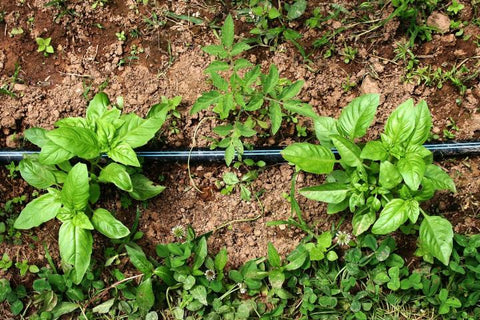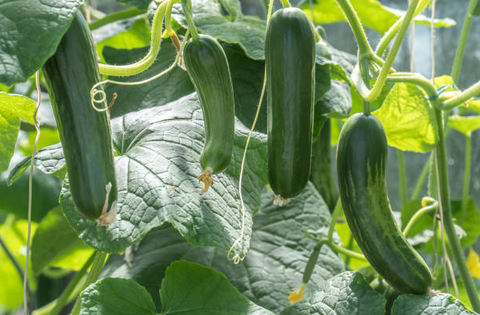In cooler temperatures, certain crops thrive and are best harvested to enjoy their peak flavor and nutritional value. Here are some examples of crops that are ideal for harvesting in cooler climates:The following content also has some reference value for raised garden beds.

Root Vegetables: Root vegetables such as carrots, potatoes, beets, turnips, and radishes are well-suited to cooler temperatures. These crops often develop sweeter flavors when grown in cooler conditions and can be harvested before the ground freezes solid, ensuring optimal taste and texture.
Leafy Greens: Leafy greens like kale, spinach, lettuce, Swiss chard, and arugula are cold-hardy crops that can withstand frost and chilly temperatures. These nutrient-packed greens thrive in cooler weather and can be harvested throughout the winter months, providing a fresh and healthy addition to meals.
Brassicas: Brassica vegetables such as cabbage, broccoli, cauliflower, Brussels sprouts, and kohlrabi are cold-tolerant crops that perform well in cooler climates. These versatile vegetables can be harvested in the fall and early winter, offering a range of flavors and textures for culinary creations.
Herbs: Many culinary herbs are well-suited to cooler temperatures and can be harvested year-round in cold climates. Herbs like parsley, cilantro, chives, thyme, and rosemary can be picked as needed, providing fresh flavors and aromas to elevate your dishes.
Alliums: Allium vegetables such as onions, garlic, leeks, and shallots are cold-hardy crops that can be harvested in cooler temperatures. These flavorful bulbs and stalks add depth and complexity to a wide range of dishes and can be stored for long periods after harvesting.
Cool-Season Crops: Cool-season crops like peas, radishes, turnips, and mustard greens thrive in cooler temperatures and can be harvested early in the growing season.
These crops are quick to mature and offer a diverse range of flavors and textures for culinary exploration.
By focusing on these crops, gardeners in cooler climates can enjoy a bountiful harvest of fresh and flavorful produce throughout the growing season and beyond.
Here are some crops to avoid planting in cooler climates:
Warm-Season Vegetables: Warm-season vegetables such as tomatoes, peppers, eggplants, cucumbers, and squash require warm soil temperatures and ample sunlight to grow and produce fruit. In cooler climates, these crops may struggle to establish and may not reach their full potential.
Tropical Fruits: Tropical fruits like bananas, pineapples, and mangoes are sensitive to cold temperatures and require a consistently warm climate to thrive. In cooler climates, these crops are unlikely to survive outdoors and are best grown in greenhouse or indoor environments.
Heat-Loving Herbs: Some herbs, such as basil and cilantro, are sensitive to cold temperatures and may bolt or go to seed prematurely in cooler climates. While these herbs can be grown in cooler temperatures with proper care, they may not reach their full flavor potential compared to when grown in warmer conditions.
Warm-Season Flowers: Flowers that prefer warm temperatures, such as marigolds, zinnias, and cosmos, may struggle to bloom in cooler climates. These annual flowers require a longer growing season and may not produce abundant blooms in regions with shorter summers and cooler temperatures.
Tender Perennials: Perennial plants that are marginally hardy or borderline tender, such as certain varieties of lavender, rosemary, and sage, may not survive harsh winter conditions in cooler climates. While these plants can often tolerate some cold, they may require protection or special care to overwinter successfully.
Frost-Sensitive Crops: Crops that are highly sensitive to frost, such as sweet potatoes, melons, and okra, should be avoided in cooler climates where late spring frosts and early fall frosts are common. These crops are more suited to regions with longer growing seasons and milder winters.
By avoiding planting these crops in cooler temperatures, gardeners can focus on selecting varieties that are better adapted to the unique conditions of their climate, ensuring a successful and productive growing season.
Harvesting the fruits of your labor is one of the most rewarding aspects of gardening, especially in cold climates where fresh produce can be scarce. Here's how to make the most of your cold-climate garden harvest:
Tips for Harvesting Crops in Cooler Temperatures

Harvesting crops in cold climates requires careful timing and attention to detail to ensure peak flavor and freshness. Harvest root vegetables such as carrots and potatoes before the ground freezes, and pick leafy greens and herbs throughout the winter months for fresh additions to your meals.
Harvesting Root Vegetables Before the Ground Freezes
Root vegetables should be harvested before the ground freezes in cold climates to prevent damage and ensure optimal flavor and texture. Use a garden fork or spade to gently loosen the soil around the roots, then carefully lift the vegetables from the ground and brush off any excess soil.
Harvesting Leafy Greens and Herbs Throughout the Winter Months
Leafy greens and herbs can be harvested throughout the winter months in cold climates, providing fresh and nutritious additions to your meals. Pick leaves as needed, using scissors or pruning shears to avoid damaging the plants, and enjoy them fresh or preserved through freezing, drying, or pickling.
Creative Ways to Enjoy Your Cold Climate Garden Harvest
Get creative in the kitchen with your cold climate garden harvest, exploring new recipes and culinary techniques to showcase the flavors of fresh produce. From hearty soups and stews to savory roasted vegetables and vibrant salads, there are endless possibilities for enjoying your garden bounty year-round.
Recipes for Hearty Soups, Stews, and Roasted Vegetables
Warm up on chilly days with hearty soups and stews made from garden-fresh vegetables and herbs. Combine root vegetables such as carrots, potatoes, and parsnips with hearty greens and aromatic herbs for flavorful and satisfying meals that celebrate the season's bounty.
Preserving Produce Through Canning, Freezing, and Pickling
Preserve the flavors of your cold climate garden harvest by canning, freezing, or pickling excess produce for later use. Make jams and jellies from seasonal fruits, blanch, and freeze vegetables for future meals, or pickle cucumbers, peppers, and other garden favorites for tangy and flavorful treats.
Expanding Your Cold Climate Raised Bed Garden
Once you've mastered the basics of cold climate gardening in raised beds, consider expanding your garden to maximize space and productivity. Here are strategies for expanding your cold climate raised bed garden
Adding Season Extension Structures: Greenhouses, hoop houses, and high tunnels are valuable additions to cold climate gardens, providing protection from frost and extending the growing season year-round. Invest in season extension structures to grow a wider variety of crops and enjoy fresh produce throughout the year.
Strategies for Growing Year-Round in Cold Climates: With the right planning and techniques, it's possible to grow food year-round in cold climates using raised beds and season extension structures. Incorporate cold-tolerant crops, utilize frost protection methods, and experiment with planting schedules to maximize your garden's potential and enjoy fresh produce in every season.
Incorporating Companion Planting and Crop Rotation: Companion planting and crop rotation are essential practices for maintaining soil health and pest management in cold climate raised beds. Plant complementary crops together to deter pests and promote pollination, and rotate crops annually to prevent nutrient depletion and disease buildup in the soil.
Maximizing Garden Space and Improving Soil Health: Make the most of your garden space by interplanting crops, using vertical gardening techniques, and incorporating raised beds with varying heights and configurations. Improve soil health and fertility through crop rotation, cover cropping, and regular additions of organic matter, creating an optimal growing environment for your plants.

Natural Pest and Disease Control Through Companion Planting: Companion planting is a natural and effective way to control pests and diseases in cold climate-raised beds. Plant insect-repellent herbs such as basil and marigolds alongside susceptible crops to deter pests, and use trap crops and beneficial insect attractants to minimize pest damage without resorting to chemical pesticides.









